
Until the past few years, cybersecurity used to be very resource-intensive, but now the rollout of 5G and AI is revolutionizing cybersecurity completely. Several activities like monitoring, hunting for threats, incident responses, etc. are now automated instead of being manual tasks. More than 93% of experts expect AI-based cyber attacks in the near future and you must be ready to handle them.
Similarly, 5G has changed telecommunications, but it has also led to new challenges and opportunities in the sphere of cybersecurity. As it is in widespread use now, organizations must know how to utilize AI and 5G to improve their security protocols and systems. In the following post, we’ll read how industries need to adapt cybersecurity to 5G and AI.
The Role of 5G & AI in Cybersecurity
The fifth gen of mobile networking, 5G has now succeeded 4G in mobile communications. It offers fast speeds, lower latency, and robust connectivity on your smartphones and other devices. However, its use can increase exposure to cyber criminals, slow down remediation, and increase vulnerability.
Using 5G safely, combining it with AI has become vital for organizations operating digitally. AI has seen so much advancement that it can offer many benefits to your cybersecurity protocols and operations currently. Through automation of labor-intensive activities, AI transforms your workflows into autonomous and streamlined processes, maximizing online safety and protection.
Cybersecurity Challenges on Adopting 5G & AI
A majority of organizations are switching over because of the potential of 5G networking. Also, a survey by Mckinsey in 2023 states that one-third of organizations utilize generative AI in some form or the other.
Moreover, 40% of organizations are increasing their investment in AI. This is revolutionary for cybersecurity but it also poses many new risks for organizations. You must know these if you want to be ready to fix and tackle them accordingly.
Increased Surfaces for Attacks
As 5G is deployed more and more, it increases the attack surface for cybercriminals due to the high data generated and more connected devices. Thus, networks are at high risk of DDoS and other attacks. Every new device on a 5G network is an entry point for attackers.
High Speed Attacks
5G offers very high-speed data transfer and volume which means cyber attacks also take place at high speed. Traditional security practices may not work in these situations and you need new frameworks to handle them.
Vulnerabilities in Supply Chain
Usually, 5G networks need a diverse and heavy supply chain to operate. If any single component is compromised, there is a huge risk of cyber attacks.
Severe & Advanced Threat Vectors
5G can support really high data rates and a large number of connected devices. Hackers can exploit them easily and launch severe DDoS and other types of attacks.
How AI & 5G Improve Cybersecurity

Despite so many new challenges, 5G and AI offer ample opportunities to improve your security. Don’t hesitate to ask for cyber security help and take advantage of the new technology.
Better Data Encryption
On 5G networks, you get really high speed and access to data encryption technologies. This allows you to improve data security, especially during the transfer of high volumes. Data is the backbone of any organization and if it is compromised, your operations are bound to fail.
Network Slicing
Through network slicing, 5G allows operators to make virtual networks inside a single network structure. Every single slice meets specific security, isolation, and performance requirements. You can isolate low-critical traffic from those that are highly critical.
Regular Audits & Monitoring
They help with regular updates of security frameworks and software. Regular cybersecurity audits make sure that there are no vulnerabilities and everything is working as intended. Through network discovery and monitoring, organizations can develop infrastructure to fight cybercriminals.
Secure IoT Ecosystem
Cyber security help and 5G scalability enable the IoT ecosystem, where you can support connections for over thousands of devices easily. Through reliability and high-speed, security goes up and you can analyze everything in real-time. Also, you can implement end-to-end security protocols across a range of connected devices.
Threat Detection Tools
Using AI-powered threat detection tools is crucial in 5G environments and networks. They analyze large amounts of data and detect any possible threats and risks. Organizations find it easier to identify and tackle large-scale cyber attacks which are complicated for traditional security methods.
Conclusion
There is a lot of potential in 5G but organizations who are making the shift need to reconsider their security strategies. There are many new challenges and risks posed and the use of AI-enabled cybersecurity frameworks has become a must.
Organizations need to understand and leverage technology if they want to stay safe and succeed in today’s digital environment. AI is revolutionizing cybersecurity and every organization must adapt as quickly as they can.
Share this post
Leave a comment
All comments are moderated. Spammy and bot submitted comments are deleted. Please submit the comments that are helpful to others, and we'll approve your comments. A comment that includes outbound link will only be approved if the content is relevant to the topic, and has some value to our readers.

Comments (0)
No comment